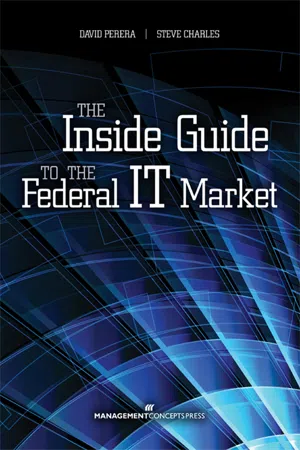
- 296 pages
- English
- ePUB (mobile friendly)
- Available on iOS & Android
The Inside Guide to the Federal IT Market
About this book
Unlock the Door to the Federal IT Marketplace
Here's your key to selling IT goods and services to the government. David Perera and Steve Charles present the ins and outs of successfully competing for—and winning—a share of the tens of billions of dollars the federal government spends each year on IT. Getting a piece of that business is not easy—it takes accurate knowledge of systems and procedures, as well as sharp insight into the structure and details of government procurement.
The Inside Guide to the Federal IT Market penetrates the haze of jargon and apparent complexity to reveal the inner workings of the IT contracting process. Whether you're just setting out or seek a bigger share, this comprehensive book provides valuable information you can put to immediate use. The Inside Guide to the Federal IT Market covers:
• Technology standards
• Basic contracting concepts
• Advanced contracting concepts, such as getting on and staying on the GSA schedules
• The effect of the federal budget process on the sales cycle
• What you need to know about ethics to earn business fairly, without avoidable delays and hassle
This book's focus on the IT market makes it a unique reference on federal procurement for private companies. Government procurement personnel will also find the depth and breadth of coverage useful in reviewing and evaluating IT offerings.
Frequently asked questions
- Essential is ideal for learners and professionals who enjoy exploring a wide range of subjects. Access the Essential Library with 800,000+ trusted titles and best-sellers across business, personal growth, and the humanities. Includes unlimited reading time and Standard Read Aloud voice.
- Complete: Perfect for advanced learners and researchers needing full, unrestricted access. Unlock 1.4M+ books across hundreds of subjects, including academic and specialized titles. The Complete Plan also includes advanced features like Premium Read Aloud and Research Assistant.
Please note we cannot support devices running on iOS 13 and Android 7 or earlier. Learn more about using the app.
Information
The Ecosystem 1
How Big a Market?
Why Agencies Buy Information Technology

Powers of the Federal CIO
Federal Attitudes Toward Technology
The Rise of Services
Table of contents
- Cover
- Title Page
- Copyright
- About the Authors
- Contents
- Foreword
- Preface
- Acknowledgments
- Chapter 1 The Ecosystem
- Chapter 2 Strictly Business
- Chapter 3 The Basics
- Chapter 4 Hoops and Hurdles
- Chapter 5 The Best Relationships Are Based on Contracts
- Chapter 6 Sign with Caution
- Chapter 7 Keep Your Nose Clean
- Chapter 8 When You Lose
- Chapter 9 Import with Care
- Chapter 10 Getting On a GSA Schedule
- Chapter 11 Let’s Get Small
- Chapter 12 The Root of All Money
- Index
- Complement Your Library with These Additional Resources from: